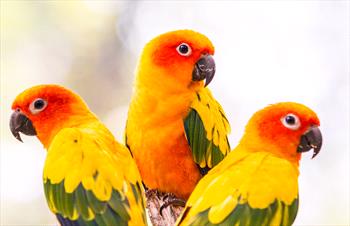Three conures

Photo courtesy of Depositphotos
What is it?
Proventricular dilatation disease is an inflammatory disease affecting the gastrointestinal and neurological systems in a variety of bird species. PDD is incurable, but manageable. Consequences of PDD range from gastrointestinal problems causing an increase in the size of the bird’s stomach to neurological symptoms. The disease is caused by avian bornavirus, which targets the bird’s nervous system. The damaged nervous system does not allow nutrients to be digested or absorbed. The virus does not always cause the disease, so a bird can have bornavirus and never develop PDD. Research on the virus and disease is still ongoing with much to be discovered.
Who gets it?
- Age: any age
- Sex: both male and female
- Species:
- Commonly Affected Species
- Macaws
- Amazon parrots
- African Grey parrots
- Cockatoos
- Electus Parrots
- Conures
- Other Species
- Chicken
- Ducks
- Falcons
- Quails
These are only some of the affected species, but more than 50 different parrot species can be affected.
How is it spread?
- Fecal-oral transmission, eating things contaminated with infected bird feces
- Direct contact with infected bird, such as sharing a cage or housing
- By air, although that is only suspected, not proven
What are the signs?
The signs can happen quickly or take time to develop. However, all the symptoms are general and are not specific to PDD.
- Undigested seed in stool
- Smelly stool
- Vomiting of undigested seed
- Eating a lot
- Weight loss
- Weakness
- Difficulty perching
- Leg paralysis
- Head tremors
- Blindness
- Seizures
How is it diagnosed?
The symptoms of PDD are not specific and there are a variety of potential causes explaining the bird’s illness such as lead toxicity, fungal or bacterial infection, or parasites. Therefore, other potential causes must be ruled out first before a diagnosis of PDD can be made. A physical examination by your veterinarian is first so a professional can see the clinical signs. Tests may include bloodwork, such as complete blood count or serology, radiographs to look for an enlarged stomach, a stomach biopsy to detect infected tissue and nerves, and other laboratory tests, such as PCR.
How is it treated?
There is no cure for PDD, so treatment reduces inflammation and the other symptoms.
- Anti-inflammatories to decrease inflammation of GI tract and nerves
- Steroids (used as a rescue drug in severe cases)
- Broad spectrum antimicrobials
- Broad spectrum antifungals
- Good nutrition
- Supplements
- Warm and dry cage
- Access to clean water
How do you prevent it?
Infected birds should be isolated for life to prevent the virus spreading to other pet birds. New birds should be isolated and tested for the virus before they are introduced to the flock. Unfortunately, there is no vaccine to protect birds from avian bornavirus.